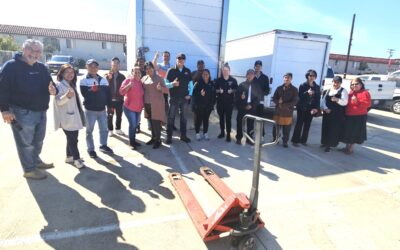
Food rescue nonprofits play a crucial role in addressing food waste and food insecurity, striving to redirect surplus food to those in need. However, funding can often be a significant challenge for these organizations. In recent years, innovative approaches such as carbon credits have emerged as potential solutions to support and sustain the work of food rescue nonprofits. This blog post explores how carbon credits can be harnessed as a funding source, benefiting both the environment and food rescue initiatives.
Understanding Carbon Credits: Carbon credits, also known as carbon offsets, are a market-based mechanism used to mitigate greenhouse gas emissions. The concept revolves around the idea of corporations compensating for their own emissions by funding projects that reduce or remove an equivalent amount of carbon dioxide (CO2) or other greenhouse gases from the atmosphere. These projects can include reforestation efforts, renewable energy installations, or methane capture from landfills.
Connecting Carbon Credits and Food Rescue: While carbon credits have traditionally been associated with environmental projects, the concept can be extended to include food rescue initiatives. Food waste is a significant contributor to greenhouse gas emissions, as decomposing organic matter releases methane, a potent greenhouse gas. By rescuing surplus food and diverting it from landfills, food rescue organizations effectively reduce methane emissions. This positive environmental impact creates an opportunity for food rescue nonprofits to generate carbon credits.
How It Works:
Quantifying the Emission Reduction: Food rescue organizations can collaborate with environmental and sustainability experts to assess the amount of greenhouse gas emissions avoided through their food recovery efforts. This analysis takes into account factors such as the volume of food rescued, transportation emissions, and the avoided methane emissions from decomposing waste. The methodology for quantifying methane emissions reduction includes details such as area disposal methods, including composting, landfilling, and burning waste to energy. The widely recognized organization that adopts standards for carbon offsets, Verra, has recently released their first Methodology For Reducing Food Loss and Waste (FLW) under the Verified Carbon Standard (VCS).
Verification and Certification: Once the emission reduction is quantified, the next step is to seek verification and certification from recognized carbon offset standards and registries. These entities ensure the accuracy and integrity of the emission reduction claims, enhancing credibility and transparency. Currently, in North America, the registry used for food rescue projects is created by the Canadian Standard Association.
Carbon Credit Creation: After verification, the food rescue nonprofits can generate carbon credits based on the quantified emission reductions. Each carbon credit represents one ton of CO2 or its equivalent greenhouse gases that have been avoided through food rescue activities.
Market Access and Trading: Carbon credits can be sold on voluntary carbon markets, where individuals, businesses, and organizations purchase them to offset their own emissions and demonstrate their commitment to sustainability. Selling credits can take up to a year on this market.
Benefits of Carbon Credits for Food Rescue Nonprofits:
Financial Sustainability: Carbon credits offer a reliable and potentially lucrative funding source for food rescue organizations. By monetizing the environmental benefits of their work, these nonprofits can enhance their financial stability and reduce dependence on traditional fundraising methods.
Scalability and Growth: With a steady revenue stream from carbon credits, food rescue nonprofits can scale up their operations, reach more communities in need, and rescue larger quantities of surplus food. This increased efficiency allows them to have an even greater impact on reducing food waste and addressing food insecurity.
Environmental Impact: Beyond the financial benefits, the creation and sale of carbon credits by food rescue nonprofits directly contribute to global emissions reductions. By tackling the root causes of greenhouse gas emissions through food waste reduction, these organizations make a positive environmental impact aligned with their mission.
Things to consider:
State-Mandated Food Rescue: One of the most disappointing aspects of utilizing carbon credits for funding food rescue is that any food rescue agencies in states where food donation is mandated by policy do not qualify for a carbon credit project. This is due to the fact that project proponents must demonstrate “additionality.” This means that projects can only be funded if there are barriers in place that would otherwise prohibit an increase in food rescues.
The Funding Math: Estimates on the price food rescue carbon credits will be sold at market vary from $10 to $25 per credit. Comparatively, agricultural or afforestation carbon credits sell for around $14 per credit. Since each credit will be calculated based on a number of factors, an exact pound of food rescued to carbon credit formula is impossible to calculate across the board. One carbon credit is equal to one ton of Greenhouse Gas emissions reduced. One organization estimates that around one million pounds of food rescued equates to about 320 credits.
Project Timelines and Costs: Carbon credits are traded on the market on a per-cycle basis, which could be as often as annually. Most projects must commit to either a 10-years fixed project or a 7-years period that can be renewed up to two times for a total of 21 years. Brokers and project managers that assist nonprofits with consulting and accounting require a minimum of carbon credits or pounds of food rescued to assist with a project. For them, a project is usually only viable if it is over 10,000 tons of food rescued or more. Brokers and Project Managers also charge a fee for their services that ranges from 30% to 49% of the total sale.
Collaborative Project Approach: Careit has met with a few organizations that are leading the movement for food rescue carbon offset credits. While this initiative is still in its infancy stages, the potential for collaboration through data aggregation is huge. As of now, projects can be funded retroactively up to rescues from 2021. And while, as of the time of writing this post, no food rescue carbon offset credits have been sold on the market, the potential interest from buyers is gaining steam. For smaller nonprofits that rescue less than 27 million pounds of food annually, collaborating with additional nonprofits within their own state on a collaborative carbon credit project will ensure the maximum feasibility that the project will attract enough resources to be viable. Careit will continue to explore pathways to connect potential project partners, including identifying a project holder that can execute agreements with individual nonprofits to fairly receive their portion of sold credits.
Summary: The integration of carbon credits as a funding source for food rescue nonprofits presents a promising opportunity to tackle both food waste and greenhouse gas emissions. By quantifying and monetizing the environmental benefits of their work, these organizations can generate revenue streams, enhance financial sustainability, and expand their impact. Embracing innovative approaches such as carbon credits empowers food rescue nonprofits to continue their vital work in building a more sustainable and equitable food system for all.









